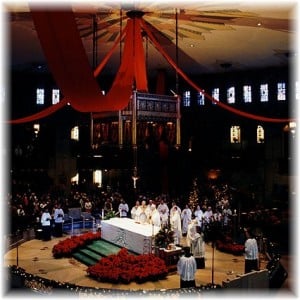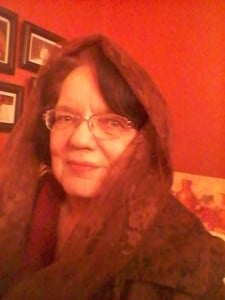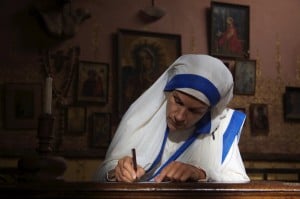 I was just a young child when I first visited the Shrine of the Little Flower. My mother and sisters crowded into the car with our neighbors and drove to Royal Oak, Michigan for a pilgrimage of sorts. We prayed a rosary at the outdoor shrine of St. Thérèse of Lisieux, and we gasped at the sheer beauty of the church which bore her name.
I was just a young child when I first visited the Shrine of the Little Flower. My mother and sisters crowded into the car with our neighbors and drove to Royal Oak, Michigan for a pilgrimage of sorts. We prayed a rosary at the outdoor shrine of St. Thérèse of Lisieux, and we gasped at the sheer beauty of the church which bore her name.
 It wasn’t until years later that I came to appreciate the rich history of the shrine. In 1925, when Royal Oak was a sparsely populated distant suburb of Detroit, Bishop Michael J. Gallagher traveled to Rome to witness the canonization of Saint Thérèse of Lisieux. Upon his return, he was determined to establish the first church in her honor here in the United States; and although only 28 Catholic families lived there at the time, Bishop Gallagher anticipated the growth which would come as a result of the booming auto industry. He named as the church’s first pastor a young priest who already had a reputation for stimulating Mass attendance: Father Charles E. Coughlin.
It wasn’t until years later that I came to appreciate the rich history of the shrine. In 1925, when Royal Oak was a sparsely populated distant suburb of Detroit, Bishop Michael J. Gallagher traveled to Rome to witness the canonization of Saint Thérèse of Lisieux. Upon his return, he was determined to establish the first church in her honor here in the United States; and although only 28 Catholic families lived there at the time, Bishop Gallagher anticipated the growth which would come as a result of the booming auto industry. He named as the church’s first pastor a young priest who already had a reputation for stimulating Mass attendance: Father Charles E. Coughlin.
 It was Father Coughlin who selected the corner of Twelve Mile Road and Woodward Avenue as the ideal location for the new church. With a loan of $78,000 from the Detroit Diocese, Father Coughlin purchased 18 lots for the new parish. A simple wooden building with a shingle roof was quickly erected at the site where the tower now stands.
It was Father Coughlin who selected the corner of Twelve Mile Road and Woodward Avenue as the ideal location for the new church. With a loan of $78,000 from the Detroit Diocese, Father Coughlin purchased 18 lots for the new parish. A simple wooden building with a shingle roof was quickly erected at the site where the tower now stands.
The parish’s website tells the story of the fundraising campaign that led to an entire new ministry for Father Coughlin, as America’s “radio priest”:
Father Coughlin, seeking a to repay the $101,000 cost of the new church, turned to creative fundraising. With the parish still in desperate need of funds, Father Coughlin took the unprecedented and surprising step of renting airtime on the Detroit radio station, WJR. Commercial broadcasting in the United States was only six years old when Father Coughlin’s Golden Hour program began in the fall of 1926. The priest’s sermons clarified the principles of Christianity and answered thousands of questions concerning faith and morals. The listeners were easily mesmerized by the man known as “The Voice” with his dramatic presentations at 2 p.m. each Sunday. Each broadcast resulted in an increasingly positive response, often accompanied by financial contributions.
By 1932, Father Coughlin’s radio chain had grown to 27 stations, stretching from Bangor, Maine, to Kansas City, Missouri. Father Coughlin and his growing staff of secretaries and assistants worked out of parishioners’ homes and various rented properties. When he outgrew these arrangements, the planning of a new church began, with provisions for much improved office space in the basement (and broadcast facilities in the second level).

In the fall of 1998, the United States Bishops’ Conference declared the Shrine of the Little Flower Church to be a national shrine. Detroit’s Archbishop Adam Maida presided over the dedication Mass, which was held on the feast of the Epiphany—January 3, 1999—in the midst of the area’s worst snowstorm in thirty years. He said,
“This day we celebrate the long faith tradition of your parish, dedicated to the spirituality of the Little Flower, Saint Thérèse of Lisieux.
“This day we celebrate that Christ was made a light to the nation. You are here at the heart and center of the Archdiocese; I hope and pray that you will be a sign of that light of Christ right here as all the world passes by. In the way that you accept the rhythm of the joys and sorrows in your own daily lives, may you bring the light of Christ to others, that they, too, may come and worship him, now and for all eternity. On this feast of the Epiphany, like the star that showed Jesus to the whole world, so your parish and this Shrine will witness to the greatness, the love, that Christ has for all God’s people.”
This video, a 2010 project of the Shrine High School journalism program, tells the story of the church’s rich history, and offers a great architectural tour.












